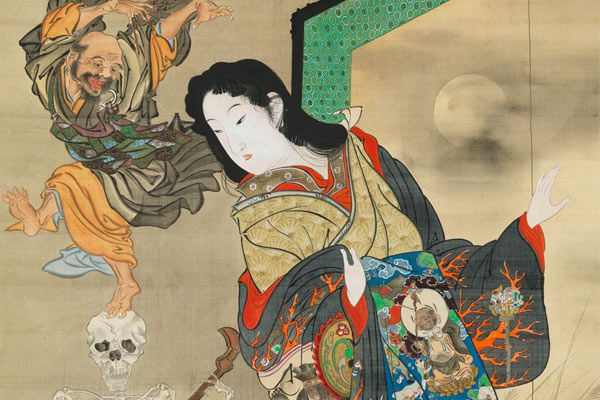
Kyōsai, the last samurai of Japanese painting
Kawanabe Kyosai - Hell Courtesan - 1871-1889Kawanabe Kyosai - Tiger Looking at Its Reflection in Moonlight - 1871-1889
From 19 March to 19 June 2022, the Royal Academy presents "Kyōsai: The Israel Goldman Collection", the first exhibition devoted to the Japanese painter Kawanabe Kyōsai (1831-1889) to be organised in the UK in almost 30 years.
Images: Kawanabe Kyōsai, "Courtesan from Hell (Jigoku-dayū), Dancing Ikkyū and Skeletons", 1871-1889. Hanging scroll: ink, colour and gold on silk. 137.1 x 69.3 cm. Collection Israel Goldman, London. Photograph: Art Research Centre, Ritsumeikan University. ·· Kawanabe Kyōsai, “Tiger looking at its reflection in the moonlight”, 1871-89. Hanging scroll: ink and gold on silk. 128.6 x 54.2 cm. Israel Goldman Collection, London. Photograph: Art Research Centre, Ritsumeikan University.
As with many other important figures in the history of art, Kawanabe Kyōsai (1831-1889) has been regarded as both the last of a tradition and the pioneer of one or more styles. Sometimes called "the most important successor of Hokusai" and "the last representative of traditional Japanese painting", his energetic and spontaneous style has also been seen as a direct ancestor of manga, and his Eshinbun Nipponchi (1874) has sometimes been considered "the first manga in history".
In a press release, the Royal Academy explains that Kyōsai "was the most exciting and popular Japanese painter of the late 19th century. A child prodigy and draughtsman of the highest ability, his art is humorous, provocative, energetic, and outrageous. The exhibition will focus largely on the art of sekiga, ‘spontaneous paintings’, produced at ‘calligraphy and painting parties’ (shogakai) which were often fuelled by prodigious amounts of saké. Overlooked for decades, many of these works reveal a comical twist which plays on conventions or reflects the artist’s take on society. Alongside these spontaneous works, highly detailed studio paintings will reveal the wide subject range Kyōsai referenced as well as his revolutionary style which challenged the rigid artistic conventions of the day. The historical context of his work will be explored, revealing the great political, social, and cultural changes taking place across Japan which he captured in his art”.
The exhibition at the Royal Academy features some 80 works from the Israel Goldman Collection, and is divided into three sections: "From Tradition to Innovation", with works demonstrating the variety of genres and styles in which Kyōsai painted; "Laughing at Modernity" presents Kyōsai within the historical framework of mid- to late-19th century Japan; and "The Artist Meets His Public", focusing on spontaneous paintings and collaborative works.
Read the full article

